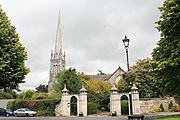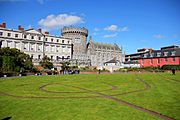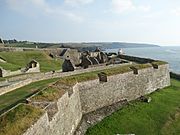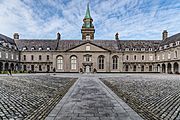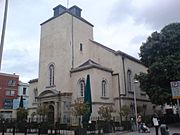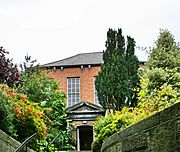William Robinson (architect) facts for kids
Quick facts for kids
Sir William Robinson
|
|
|---|---|
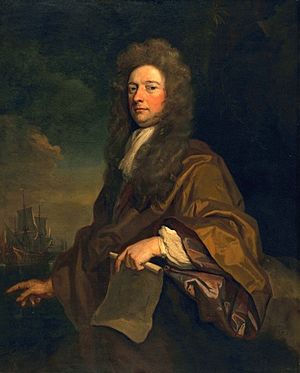
Portrait of Robinson by Godfrey Kneller (1693)
|
|
| Surveyor General of Ireland | |
| In office February 1671 – April 1700 Serving with William Molyneux (1684–1698)
|
|
| Preceded by | John Morton |
| Succeeded by | Thomas de Burgh |
| Personal details | |
| Born | 1644 Yorkshire, England |
| Died | 1712 London, Great Britain |
| Resting place | St Martin-in-the-Fields, London, England |
| Spouse | Margery Tooke |
| Profession | Architect and politician |
Sir William Robinson (May 1644 – October 1712) was a talented British architect, military engineer, and politician. He worked for the government in Dublin Castle. He was the Surveyor General of Ireland from 1671 to 1700.
Robinson was very important in shaping the look of classical architecture in Ireland. He designed many buildings in the English Baroque style. Many of his famous works are in Dublin.
Contents
About William Robinson
Robinson was born in Yorkshire, England, in 1644. His father was Walter Robinson. He probably learned architecture in England. Around 1670, he moved to Ireland.
Becoming Surveyor General
On February 7, 1671, Robinson became the Surveyor General of Ireland. This was a very important job. He was appointed by John Berkeley, who was the Lord Lieutenant of Ireland at the time. Robinson also worked as an engineer and master of the ordnance.
By 1675, he had managed many building projects and repairs in Dublin. These included Chapelizod House and Dublin Castle. From 1677, he designed and helped build Charles Fort in County Cork. He also checked on the condition of Irish forts.
Other projects he worked on included building Essex Bridge in Dublin. He also helped rebuild Lismore Cathedral in County Waterford. His job as surveyor general was renewed in 1679. His salary was doubled to £300.
Major Architectural Works
In the 1680s, Robinson designed the Royal Hospital Kilmainham. This building was inspired by Les Invalides in Paris. The Royal Hospital is seen as Robinson's best work. For a while, people thought Sir Christopher Wren designed it by mistake.
In 1682, Robinson oversaw the building of Ormond Bridge in Dublin. He also became an auditor for the Royal Hospital in 1684. His surveyor general job was renewed again in 1684. This time, he shared the role with William Molyneux. In 1686, Robinson worked on rebuilding St. Michan's Church, Dublin.
Political Life and Later Years
When Richard Talbot, 1st Earl of Tyrconnell became Lord Lieutenant in 1687, Robinson left Ireland for England. He came back to Ireland in 1689 during the Williamite War in Ireland. During this war, he held several important roles in the army of King William III.
He became a commissioner for forfeited estates in 1690. He also got his job back as surveyor general. In 1692, he became a deputy paymaster for the army in Ireland. He also became a justice of the peace in England.
In August 1692, Robinson helped get a large loan of £30,000 for the Irish government. This was very important at the time.
Robinson was elected to the Irish House of Commons in 1692. He represented Knocktopher. In 1693, his portrait was painted by the famous artist Godfrey Kneller. He was elected again in 1695 for Wicklow.
He rebuilt the old Four Courts in Dublin in 1695. He signed the Association of 1696, which was a pledge of loyalty to the king. He later became a governor of the Royal Hospital, Kilmainham. He stopped being surveyor general in April 1700 due to his health. Thomas de Burgh took over his role.
On June 19, 1702, Robinson was made a knight. He also joined the Privy Council of Ireland that same year. His last major architectural project was Marsh's Library, which he designed in 1703. He was elected as a Member of Parliament for Dublin University in 1703.
In 1703, Robinson faced some serious questions about how he managed public money. He was accused of misrepresenting the public debt. This caused a big financial scandal. He narrowly avoided being removed from parliament. In 1706, he left Ireland and returned to England. This was due to ongoing investigations about how he handled army funds.
Personal Life
On January 18, 1677, Robinson married Margery Tooke. She was from Hertfordshire. Robinson did not have any children. He died in October 1712 and was buried in St Martin-in-the-Fields, London. He owned several homes and was said to be very wealthy when he died.
List of Works by William Robinson
- St. Mary's Abbey, Dublin (1676) – partial demolition
- Essex Bridge (1676)
- Charles Fort (1677–82)
- Chichester House (1677–78)
- Lismore Cathedral (1679)
- Ormonde Bridge (1682)
- Dublin Castle (prior to 1685)
- Chapelizod House (prior to 1685)
- St. Michan's Church, Dublin (1686)
- Old Four Courts, Winetavern Street (1695)
- Royal Hospital Kilmainham (1679–87)
- St Mary's Church, Mary Street, Dublin (1700–01)
- Marsh's Library (1705)
Gallery of Major Works
- Gallery of Robinson's major works in Ireland
-
Lismore Cathedral, completed in 1679. Gateway was completed at a later date.
-
Dublin Castle, various works in the 1670s and 1680s.
-
Charles Fort, completed in 1682.
-
Royal Hospital Kilmainham, completed in 1684.
-
Marsh's Library, completed in 1705.


